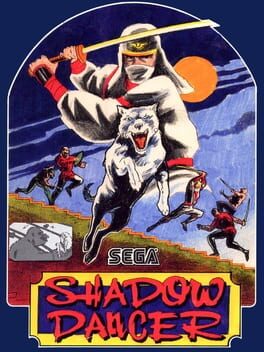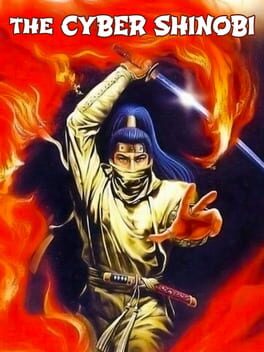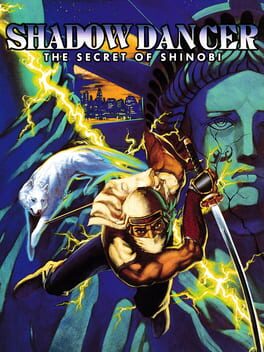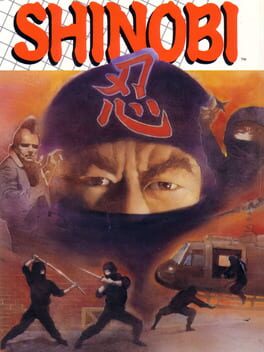

The play mechanics of Shadow Dancer are not much different from the arcade version of the original Shinobi. The controls and almost all of the player's moves from the original Shinobi are present here as well. The biggest change is the addition of a canine companion that follows the protagonist around. When the dog barks towards an enemy, the player can sic the dog on the enemy by holding down the attack button and releasing it, allowing the player an opportunity to attack the enemy while he's being bitten by the dog. However, if the player takes too long to attack the bitten enemy or the enemy has a strong defense, then the dog will be hurt and he will turn into a harmless pup and will remain in that form until the player acquires the next time bomb or finishes the stage. The dog does not appear during boss battles. The player's weapons consists of an unlimited supply of shurikens and a sword which is used when adjacent to an enemy. When the player collects half of the time bombs in each stage, stronger weapons are granted until the player finishes the stage or loses a life. The player can also use from one of three random "Ninja Magic" spells that will clear the entire screen of enemies. Normally, these spells can only be used once per stage, but if the player inserts another credit after getting a Game Over and continues, the protagonist will restart with two units instead of one. If the player completes a stage without using shurikens or spells, bonus points are awarded. There are four different missions, consisting of three stages for the first mission and four stages each for the remaining three. In the first few stages of each mission, the player must collect a certain amount of time bombs scattered throughout the stage in order to proceed to the goal. The final stage in each mission is a confrontation between the player and the boss. Between missions, the player will participate in a bonus stage where (from the character's perspective) an army of ninjas dropping down from a building must be shot down. If the player successfully completes a bonus round, an extra life is awarded.
Also in series
Released on
Genres
Reviews View More
The addition of the dog companion was really cool, very creative and allows for some fun interactions with the level. I felt as though it didn't function as well as it should've, though. The input to sic your dog on enemies is down+A, but only if your dog is barking. Sometimes I'll be standing next to an enemy or a couple inches above them and the dog won't bark so I can't attack, or I'll just be trying to use a ducking attack and my dog will go and get himself killed when I didn't want him to attack. It's a bit of a frustrating mechanic that I think could've been solved with its own button (or maybe use crouch+C to use dog attacks, and standing C would be the ninja magic?).
A lot of the enemies were more obnoxious to fight in Shadow Dancer than in Shinobi. The big Chinese guys that threw their swords at you in the first game have been replaced by these guys with chakram shields? Sometimes they throw them, and sometimes they just stand there and don't do anything. The ninjas are especially obnoxious to fight now, since crouching A sics your dog, so I don't get to do crouching kicks or crouching shurikens to deal with them sometimes.
Many of the bosses were cool, but not as cool as Shinobi 1's. You fight an armored ninja that shoots fireballs, a ninja-dispensing helicopter, a giant robot head protected by walls of Hindi statues, and a samurai before the final boss. This game has a samurai that throws rubber bouncy balls at you, a train, and a lady standing behind a barrier throwing floppy disks. I know this sounds a bit disingenuous as a critique, since the bosses themselves aside from the final one in this game are still sorta fun to fight. But it's just something about the presentation of this game that isn't doing it for me. The bosses were much more dynamic and impressive. The giant helicopter fight of the first game especially was really cool.
The final boss was pretty disappointing and the ending was super anticlimactic, aside from the really amazing cutscene of watching the rocket take off into outer space. Did I get a bad ending for beating the game with more than 1 credit or something? The first game ended with a fight against the masked ninja, who used all your moves against you, and there was a really cool reveal of his identity. The only thing that happens in Shadow Dancer is you knock some lady with a guandao off the launch platform to the rocket and she does the Inseminoids scream.
The fight itself isn't even that fun, you just stand and spam shurikens at her barrier (the effect itself looks really cool) while she launches little tiny demon ninjas at you. And then when she runs out, you just mash shurikens at her, hop over her attacks and hope your shurikens connect with her exposed hitbox while she swings at you. It felt kind of lame and cheesy as opposed to an actual fight where you tried to carefully and precisely land your shurikens at a weak spot like Ken-Oh or Lobster. Most of the fights are easily cheesed, actually. The Mission 3 boss, the one I said looks like a lady throwing floppy disks at you, you can just clip your character's hand through her barrier and hit her with shurikens, you just need to be careful and back off before the barrier moves forward and hits you.
I like that the high score at the end actually displays how many credits it took the player to beat the game. I think more arcade games should show that. If someone did a one-credit run, that should be known to people checking the leaderboards because that's a seriously impressive feat.
This isn't a bad game at all, I just didn't really like it ig.
Final high score: 535,850
https://youtu.be/h9pzFH4LcGw
One thing worth noting is that the arcade version of Shadow Dancer is a different game from the Genesis version. The Genesis version is probably a bit superior overall, I'd say, but they're close enough in quality that playing both is my recommendation. There aren't all that many Shinobi-likes running around, so why not enjoy both?
Shadow Dancer really isn't much different from Shinobi, but the things it adds make a notable difference, the main one being the addition of a dog companion. Not only is that inherently cool because it's a dog, it adds a really nice layer of strategy that the game takes full advantage of. Your canine friend can be sicced on an enemy to stun them and leave them open to attack. This is great for reducing the amount of attacks coming your way if you need to handle a pincer situation or if you're not quite sure how to get past a trigger happy enemy. It's not a foolproof thing, though, because the dog can be hit by enemies and rendered unusable for just long enough that his absence will get you killed. Thus, you need to know what enemies to sicc him on and when to keep him at your side for something that might come up later. Enemies that use guns are a prime target if they're not crouching, whereas enemies with shields will usually knock him away before he can do anything. He's an unlimited resource, but not one that's without flaws, lending Shadow Dancer an interesting ebb and flow that gives it an identity when compared to the original game.
Shinobi, like Rolling Thunder before it, is all about approaching an engagement from the right angle or with the right timing. Combat itself is little more than just pressing the button because you and everyone else are taken out in a single hit, but how you choose to start the battle is the difference between cleanly surviving or ending up in an unavoidable deathtrap. Shadow Dancer uses the addition of the dog to provide new kinds of situations that strongly encourage a calculated approach. A lot of the level design is even more vertically oriented than in the original, which leads to plenty of situations where the enemy has the high ground or you're "forced" to step down into an obvious trap. Normally, these situations could be cheap, but having your dog friend lets you get the jump on them in ways not possible. That risk is ever present, though - what if you use the dog to get past the next segment only for the next one to throw a jumpscare at you that would be way easier if he wasn't on cooldown? Well, that's where the game's place as an arcade title comes into play; you're gonna die, you're gonna have to learn where enemy placements are, but once you do, you really can take out every single foe with surgical precision and the exact right allocation of resources just like a ninja should.
Beyond that, Shadow Dancer plays it faithful. You've got four areas, including caves, an airport, a bridge, and sewers, boss fights, and a between level minigame that feels like it's impossible even though it surely isn't. The aesthetics are totally on point, as you'd expect from a Sega game, so much so that there's graffiti on one of the walls that literally says "Sega Aesthetics"! There's a dark, grungy vibe to Shadow Dancer that's far removed from Sega's blue skies reputation, but it really works for creating an atmosphere of tension, one where you never quite know what's going to jump out at you. The bosses are an interesting batch, too, the most notable of which being a robot train thing and the final boss, who summons these weird, tiny floating ninjas at you? It's very strange and actually made me laugh out loud the first time I saw it, I'll admit, but when she drops the act and comes at you herself, it goes from funny to nightmarishly difficult!
Shadow Dancer is everything good about the original Shinobi and more. The dog adds a lot, the level design is even more thoughtful, the visuals are improved, the new power-ups instill even more variety, and the difficulty is more reasonable. They even cut out the "preventing continues during the last boss without warning" thing that nobody likes! Though Shadow Dancer ultimately wasn't the future of the series and isn't on the level of Revenge or Shinobi III, it's still a quality game worth running through at least once. There are different schools of design one can apply to Shinobi, all of which proved to be successful in their own ways, so having a "definitive" version of the original style in the form of both Shadow Dancer games is a very nice thing to have. Even if you prefer the later Shinobi games, heck, especially if you do, you should really give this one a try to get a better idea of how the series became successful in the first place. Sometimes, it takes thoughtful iteration on something to understand what choices are timeless and which ones need to evolve with the times before you can really go wild with future ideas. You gotta practice your dancing before you can become a master, after all!





